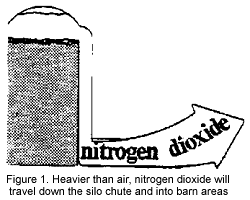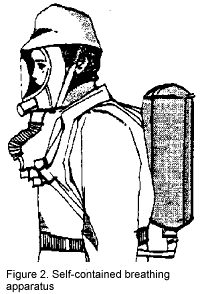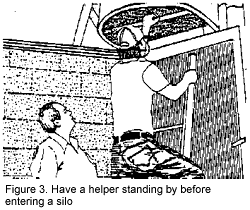We have all heard the old saying, "a little knowledge is a dangerous thing." This is true of many aspects of farming, and in particular with silo gases. In fact, where these gases are involved we ought to add that "No knowledge can be fatal." Although accidents caused by silo gases may not occur as often as other kinds of farm accidents, they are and will continue to be a very real hazard for as long as silage remains a common livestock feed. Because of this, it is important that every farm worker understand the danger associated with silo gases and how to deal with them.
WHAT ARE SILO GASSES?
 Silo gas is formed by the natural fermentation of chopped silage
shortly after it is placed in the silo. Though a variety of
gases are released during this process, the type of silo in
which the forage is stored is important in determining which
gas will be predominant. For instance, in sealed silos both
nitrogen and carbon dioxide gases are created but carbon dioxide
is produced in far greater amounts. This is desirable because
high carbon dioxide levels help to maintain high quality silage
. At the same time, however, this odorless and colorless gas
is dangerous. This gas replaces the silo's oxygen, and in high
concentrations, it gives a person little warning that he is
about to be overcome. Because of this hazard, sealed silos are
designed in such a way that entering them is unnecessary.
Silo gas is formed by the natural fermentation of chopped silage
shortly after it is placed in the silo. Though a variety of
gases are released during this process, the type of silo in
which the forage is stored is important in determining which
gas will be predominant. For instance, in sealed silos both
nitrogen and carbon dioxide gases are created but carbon dioxide
is produced in far greater amounts. This is desirable because
high carbon dioxide levels help to maintain high quality silage
. At the same time, however, this odorless and colorless gas
is dangerous. This gas replaces the silo's oxygen, and in high
concentrations, it gives a person little warning that he is
about to be overcome. Because of this hazard, sealed silos are
designed in such a way that entering them is unnecessary.
A variety of gases are also formed in conventional or open-top silos; but in these, nitrogen dioxide is found more abundantly. This highly toxic gas is characterized by a strong bleach-like odor and low lying yellow, red, or dark brown fumes. Unlike carbon dioxide, nitrogen dioxide levels reach a peak about three days after harvesting and rapidly begin to decrease thereafter, particularly if the silo is ventilated. After two weeks it is unlikely that more gas will be produced, although some hazard remains if the gas has not been able to escape the silo.
Nitrogen dioxide is harmful because it causes severe irritation to the nose and throat and may lead to inflammation of the lungs. However, what makes this gas especially dangerous is that low level exposure to it is accompanied by only a little immediate pain or discomfort Though death can occur immediately, a farmer might breathe the gas without noticing any serious ill effects and then die in his sleep hours later from fluid collecting in his lungs. Also, many victims suffer relapses with symptoms similar to pneumonia two to six weeks after the initial exposure. For these reasons, it is extremely important for anyone who is exposed to this gas, even a short time, to seek immediate medical attention.
Like carbon dioxide, nitrogen dioxide is heavier than air. Because of this, as it is produced it tends to settle right on top of the silage or flow down the silo chute and collect in the adjoining feed rooms or other low lying areas near the base of the silo (see Figure 1). Gas may even flow into the barn itself and become trapped in corners, under feed bunks, or lie low against the floor. The threat that this poses to livestock is a serious one. To prevent silo gases from poisoning your livestock, provide good ventilation wherever possible in and around the silo when silage is fermenting. It is important, too, that the door between the feed room and the barn be kept closed.
SILO SAFETY PRACTICES Safety of your family is more important than that of the livestock.
Children should be of special concern because the silage operation
is often a fun event for them. It may be difficult to keep them
away from the silo during its filling or for the two weeks when
dangerous gases are present. Therefore, it is essential that
the seriousness of this hazard be clearly communicated to each
family member. But do not rely on this warning alone. Since
you know best the layout of your silo areas, d what you think
is necessary and reasonable to keep young ones from straying
into them. This could mean padlocking doors, or in some instances,
even placing fences or barricades in needed locations.
Safety of your family is more important than that of the livestock.
Children should be of special concern because the silage operation
is often a fun event for them. It may be difficult to keep them
away from the silo during its filling or for the two weeks when
dangerous gases are present. Therefore, it is essential that
the seriousness of this hazard be clearly communicated to each
family member. But do not rely on this warning alone. Since
you know best the layout of your silo areas, d what you think
is necessary and reasonable to keep young ones from straying
into them. This could mean padlocking doors, or in some instances,
even placing fences or barricades in needed locations.
Ideally, every farmer should also avoid the silo during the critical period when gases are forming. With the enclosed silo this is easily done. Unfortunately, it is not always so easy to keep away from a conventional silo, for example: machinery breaks down, chute covers must be put on, and filling the silo is usually not accomplished in one cutting. Because entry into these silos sometimes becomes necessary while nitrogen dioxide might be present, it is best to use a self-contained breathing apparatus (see Figure 2). This is the only breathing device that is certain to protect you from all silo gases. Do not expect dust masks or even chemical cartridge respirators to provide sufficient protection. Neither is intended for use where gases are extremely toxic or where the air has been replaced by gases such as carbon dioxide. Unfortunately, the intricate components which make the self-contained breathing apparatus (SCBA) effective against silo gases also makes it expensive to buy; nor are self-contained breathing apparatus s easy to fit or use without proper training.
If you do not have a self-contained breathing apparatus, stay out of the silo during the first two to three days after filling. If you must enter the silo after the first few days, it can usually be done safely if the following precautions are observed. First, ventilate the silo and all adjacent areas thoroughly before, entering. This can be done by running the silo blower for fifteen to twenty minutes before, going into the silo, by opening all upper chute doors down to the level of the settled silage, and by opening the windows in the feed rooms. The blower should remain in operation for the entire time you are inside. An important thing to remember is that the lower the level of silage in the silo, the greater the risk that the ventilation from the silo blower is insufficient to adequately dilute the silo gas. In other words, there is no guarantee that silo blower ventilation will make it safe for you to enter the silo without a self-contained breathing apparatus.
 Next, you should never enter a silo unless another person
is present, one who could go for help should you need it (see
Figure 3). This person should maintain visual contact with
you. If gases are present,you may not have a chance to call
out before, becoming unconscious or other sources of noise
may drown out your attempts to gain someone's attention. Finally,
though it will not protect you from silo gases, wear a dust
mask or some other respirator to protect your lungs from the
high concentrations of dust and mold spores which are found
in silos.
Next, you should never enter a silo unless another person
is present, one who could go for help should you need it (see
Figure 3). This person should maintain visual contact with
you. If gases are present,you may not have a chance to call
out before, becoming unconscious or other sources of noise
may drown out your attempts to gain someone's attention. Finally,
though it will not protect you from silo gases, wear a dust
mask or some other respirator to protect your lungs from the
high concentrations of dust and mold spores which are found
in silos.
Preventing accidents caused by the inhalation of silo gas is, in theory, very simple. Whether or not this is true in your experience depends upon your willingness to practice these safety tips.
Regard
silo gases as a real hazard NOW! Don't wait until you become
a statistic.
Publication #: 16
This document was published in 1991 as Pennsylvania State University Fact Sheet Safety , Pennsylvania Cooperative Extension Service. For more information, contact Pennsylvania State University College of Agricultural Sciences, Agricultural Engineering Department, 246 Agricultural Engineering Building, University Park, PA 16802.
Dennis J. Murphy, professor, Agricultural Engineering Department, Cooperative Extension Service, Pennsylvania State University, University Park, PA 16802.
Disclaimer and Reproduction Information: Information in NASD does not represent NIOSH policy. Information included in NASD appears by permission of the author and/or copyright holder. More